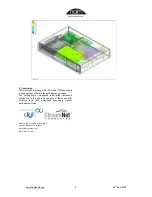
www.naimaudio.com
- 1 -
24
th
April 2008
Hard Disk Player Thermal Analysis
Paul Neville
Naim Audio
Southampton Road, Salisbury, SP1 2LN, England
Abstract
When designing hi-fi components attention has to be
paid to the thermal performance. Excessive heat would
cause longer term reliability problems and short term
problems in adhering to the various safety standards
around the world. Naim products are sold and used
worldwide in many climates.
1. Target Performance
The specification required the unit to run happily at
ambient temperatures at or below 25 degrees C without
the use of a fan to cool the components. At higher
ambient temperatures the fan would be required to run
to keep components inside the box cool.
2. Modelling
To optimise the thermal performance of the Naim Hard
Disk player and server products a combination of
computer analysis and verification testing was used.
Using the mechanical CAD model of the product as a
start point, a thermal model was created and analysed
using FEA (Finite Element Analysis) and CFD
(Computational Fluid Dynamics) to predict airflow
patterns within the product and the temperatures of key
components. This involved calculating heat output
values for all the heat generating components such as
processors, power supplies and both hard drives.
The software uses these values and the thermal
properties of the materials to predict the flow patterns
and maximum temperatures reached from a meshed
model. The software model predicted temperatures at
different ambient temperatures and with the fan turned
on or off. It was also possible to use the model to
optimise the position of the fan and to confirm that the
planned airflow was ideal.
The Thermal model allowed predictions of what would
happen when materials or the design changed and to
fine tune the design for thermal performance.
The product case is constructed from 5mm thick
aluminium, which provides an in-built heat sink for the
components and a path to remove heat from the
product. Key components have been coupled to the
case to provide a direct conductive heat path to the
cover and hence, the outside world. For instance the
hard drives are connected directly to the cover via thick
machined aluminium blocks.
The back-up drive is sent to sleep when not in use to
limit the heat that is generated and the primary drive is
located closest to the cover to shorten the distance of
the heat path to the outside world.
The best grades of material were selected to minimise
thermal resistance to provide a product with optimum
passive cooling. The final product was sent to the design
and verification test centre of Seagate (the hard drive
manufacturer) who confirmed our analysis and testing.
The results indicated that “the drive will remain within
specification limits up to ambient conditions over 40°C
even with the fan off.”
We have chosen to use the fan at ambient temperatures
above 25 Degrees C to maintain the best reliability of the
hard drives (the fan is controlled by monitoring the on
board temperature sensor on the hard drives). The
product also monitors the motherboard processor
temperatures.




















